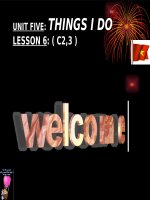G1 selective lessonplan unit5
Bạn đang xem bản rút gọn của tài liệu. Xem và tải ngay bản đầy đủ của tài liệu tại đây (611.71 KB, 18 trang )
Family and Friends Special Edition Grade 1 – Unit 5: He’s happy!
Lesson One Words
Objectives
To learn feeling words
To practice feeling words in the form of a chant
Language
Language focus: reading, listening
Vocabulary: happy, sad, hungry, thirsty, hot, cold
Resources and materials
Student Book p. 36
Workbook p. 36
Audio Tracks 59–60
Flashcards 21–26, 27–32
Stickers
Worksheet 1: Word scramble (one per pair)
Introduction
Weather report: Ask the class about today’s weather.
Song: Play the Hello song (Track 01) to introduce the lesson and for children to sing along.
Warmer: Snap!
Use Flashcards 21–26 to review the vocabulary from the previous unit.
Write one of the items from the vocabulary set on the board, e.g., mom. Say the word out loud.
Put the flashcards in a pile and hold them up so that the children can only see the facing card. Reveal the cards one at
a time by putting the front card in back. When children see the card for mom, they shout Snap!
Repeat with the rest of the words in the set.
Lead-in
Use Flashcards 27–32 to introduce the vocabulary for this lesson.
Hold them up one at a time and say the words for children to repeat in chorus.
Give the flashcards to six children. They take turns standing up and showing their card for the class to shout out the
word.
Presentation
Listen, point, and repeat. (Exercise 1)
Say Open your books and model the action for children to copy. Point to the feeling pictures.
Play the first part of the recording (Track 59, Listen and point). Hold up your book and point to the pictures in time
with the audio. Children listen and point to the appropriate pictures.
Play the second part of the recording (Track 59, Listen and repeat) for children to repeat the words in chorus.
Play the recording all the way through for children to point to the pictures and repeat the words.
Hold up the flashcards one at a time and ask individual children to say the words.
Transcript (Track 59)
Listen and point.
happy, sad, hungry, thirsty, hot, cold
sad, hungry, cold, thirsty, hot, happy
Listen and repeat.
happy, sad, hungry, thirsty, hot, cold
Match the opposites (Optional activity 1)
Use Flashcards 27–32 to practice opposite words: happy/sad, hungry/thirsty, hot/cold.
Hold up the card pairs and say the words. Put the card pairs on the board. Practice them with the class.
© Oxford University Press 2015
1
Family and Friends Special Edition Grade 1 – Unit 5: He’s happy!
Turn over all of the cards. Then turn over one of the cards in each pair so that only one card is visible. Elicit the words
from the class until all the cards are visible.
Listen and chant. (Exercise 2)
Play the recording (Track 60) for children to listen to the chant. Hold up your book and point to the pictures as you
hear them.
Play the chant a second time for children to say the words. Demonstrate an action for each word: happy (wave arms
in the air), sad (mime crying), hungry (rub tummy), thirsty (mime drinking), hot (fan your face), cold (shiver).
Divide the class into groups of six. Give each group a line from the chant.
Say the chant with the class and do the actions for children to copy.
Each group says their line and does the correct action in time with the audio.
Transcript (Track 60)
Listen and chant.
happy, happy
sad, sad
hungry, hungry
thirsty, thirsty
hot, hot
cold, cold
Chant the opposites (Optional activity 2)
Play the chant again (Track 60).
Pause the recording at every alternate line and elicit the words from the children. Remind them that the words will be
the opposite of the words in the previous line. Use flashcards if necessary.
Development
Point and say. Stick the stickers. (Exercise 3)
Hold up your book and point to the picture. Point to Billy and say happy. Point to each family member one at a time
and say the appropriate feeling words for each character.
Repeat and encourage the children to point to the pictures and say the words with you in chorus.
Say Let’s stick the stickers. Take the happy sticker and show it to the class. Place it on the caption box and say happy.
Tell children that Billy is happy because he’s just learned to walk.
Children copy you and place all the stickers in the correct caption boxes.
Monitor and help where needed.
Consolidation
Word chain (Optional activity 3)
Put the flashcards on the board in a sequence, e.g., hot, cold, happy, sad, thirsty, hungry.
Have the class repeat the sequence.
Remove one flashcard. The class repeats the sequence including the missing word. Remove one more flashcard each
time, until children are saying the whole sequence from memory.
Worksheet 1: Word scramble
Hand out the worksheet, one to each pair of children.
Ask children to look at the worksheet and work in pairs to make words from the lesson with the scrambled letters.
If you think children need extra support, you can write the words on the board or display Flashcards 17–32 for
children to refer to.
When they have finished, they can color the pictures.
Check the answers with the class.
Exercises: Workbook p. 36
Story time: A reader of your choice
© Oxford University Press 2015
2
Family and Friends Special Edition Grade 1 – Unit 5: He’s happy!
Worksheet 1: Word scramble
Unscramble the letters to make words.
pphay _ _ _ _ _
dsa _ _ _
lodc _ _ _ _
oht
___
sityhtr _ _ _ _ _ _ _
gnuhyr _ _ _ _ _ _
© Oxford University Press 2015
3
Family and Friends Special Edition Grade 1 – Unit 5: He’s happy!
Lesson Two Grammar and song
Objectives
To say the sentences He’s (happy). She’s (hungry).
To sing a song
Language
Language focus: listening, speaking, writing
Vocabulary: He’s (happy). She’s (hungry).
Extra vocabulary: happy as can be
Review: boy, girl, happy, sad, hungry, thirsty
Resources and materials
Student Book p. 37
Workbook p. 37
Audio Tracks 60, 61–62
Flashcards 27–32
Phonics cards 3 (Bb boy), 13 (Gg girl)
A sheet of paper for each child (optional)
Introduction
Weather report: Ask the class about today’s weather.
Song: Play a warm-up song.
Warmer: Musical cards
Play lively music or the chant from the previous lesson (Track 60).
Hand out Flashcards 27–32 to different children around the class. They pass the cards to children next to them while
the music is playing.
Stop the music suddenly. Ask the children who are holding cards What is the feeling? to elicit the words.
Play the music and continue in this way.
Lead-in
Put Flashcards 27–32 on the board. Point to each one, one at a time, and say the word. Then point to the cards and
do a mime for each one.
Put the cards face down on the table. Choose a card one at a time and mime the word for the class. Children shout
out the word.
Presentation
Listen and repeat. (Exercise 1)
Draw a smiley face on the board. Point to it and say He’s happy. Draw another smiley face with long hair and say She’s
happy. Repeat until children understand the difference between He’s and She’s.
Put Flashcard 27 on the board. Point to the flashcard and elicit She’s happy.
Play the recording (Track 61) and say the words in time with the audio.
Play the recording again for children to repeat the words in chorus.
Repeat and practice with all the flashcards.
Transcript (Track 61)
Listen and repeat.
He’s happy. She’s hungry.
Draw happy or sad (Optional activity 1)
Use Phonics card 3 (/b/ boy) and 13 (/g/ girl) to review He’s and She’s. Point to each card one at a time and say He’s a
boy. She’s a girl. The children repeat in chorus.
Give each child a sheet of paper. Ask them to draw a picture of a smiley face or a sad face. Tell them to draw a big
face so that it fills the page.
© Oxford University Press 2015
4
Family and Friends Special Edition Grade 1 – Unit 5: He’s happy!
Children take turns standing up and holding their picture in front of their face. The rest of the class shouts He’s / She’s
happy or He’s / She’s sad. Monitor and make sure they use He’s and She’s correctly.
Listen and sing. (Exercise 2)
Hold up the book and point to the pictures.
Play the recording (Track 62) all the way through. Children listen as you sing along. Repeat the mimes you did in
Lesson 1 when you said the feeling words.
Play the recording again. As you sing, hold up Flashcards 27–30 and do the actions.
Play the recording again for the children to sing the song and do the actions.
Play the recording once again, stopping after each verse. Ask children to locate the people in the pictures for each
verse.
Transcript (Track 62)
Listen and sing.
Happy! Happy!
Look at the boy.
He’s happy.
Happy! Happy!
Happy as can be.
Sad! Sad!
Look at the girl.
She’s sad.
Sad! Sad!
Sad as can be.
Hungry! Hungry!
Look at the boy.
He’s hungry.
Hungry! Hungry!
Hungry as can be.
Thirsty! Thirsty!
Look at the girl.
She’s thirsty.
Thirsty! Thirsty!
Thirsty as can be.
Sing your part (Optional activity 2)
Divide the class into four groups. Give each group a verse to sing. Give one child in each group one of the flashcards
(Flashcards 27–30).
Play the recording again (Track 62). Each group sings their verse and the child in the group holds up the flashcard
when they sing the verse.
Development
Point and say the differences. (Exercise 3)
Hold up your book and point to the two pictures.
Point to the girl in the red shirt in picture 1 and say She’s sad. Point to the same girl in picture 2 and say She’s happy.
Repeat and encourage the children to repeat in chorus.
Point to the man with the hat in picture 1 and say He’s thirsty. Point to the girl in picture 2 and say She’s thirsty.
Point to the pictures one at a time and say the differences. Encourage the children to speak in chorus with you.
Answers
The woman in the green shirt is happy in picture 1. She’s sad in picture 2.
The man in the white shirt is sad in picture 1. He’s happy in picture 2.
The man with the hat is thirsty in picture 1. The girl with the green shirt is thirsty in picture 2.
The woman with the orange shirt is sad in picture 1. She’s happy in picture 2.
© Oxford University Press 2015
5
Family and Friends Special Edition Grade 1 – Unit 5: He’s happy!
The girl with the red shirt is sad in picture 1. She’s happy in picture 2.
The girl with the blue dress is cold in picture 1. She’s hot in picture 2.
The boy with the red shirt is hungry in picture 1. He’s happy in picture 2.
Mime it! (Optional activity 3)
Display Flashcards 27–32 on the board.
Ask children to work in pairs. The first child chooses one word and mimes it, e.g., smiling and dancing for happy. The
second child guesses the words and says, e.g., He’s/She’s happy.
Children then switch roles.
Children continue playing with other feeling words.
Consolidation
Let’s Practice!
Ask students to look at the picture and speech bubble.
Have two students demonstrate the question in the speech bubble and the answer in the picture.
Have students work in pairs to ask and answer the question. Tell them to use other vocabulary words from Lesson 1.
You may want to give each student a piece of paper to draw a picture of someone with one of the feelings. Have
them share their pictures in pairs or groups, saying He’s/She’s (cold).
Exercises: Workbook p. 37
Story time: A reader of your choice
© Oxford University Press 2015
6
Family and Friends Special Edition Grade 1 – Unit 5: He’s happy!
Lesson Three Sounds and letters
Objectives
To recognize the uppercase and lowercase forms of the letter m and associate them with the sound /m/
To pronounce the sound /m/
Language
Language focus: listening, speaking
Vocabulary: man, mango
Extra vocabulary: eats
Resources and materials
Student Book p. 38
Workbook p. 38
Audio Track 63–64
Flashcards 27–32
Phonics cards 25–26
Stickers
Introduction
Weather report: Ask the class about today’s weather.
Song: Play a warm-up song.
Warmer: Listen, point, and say
Place Flashcards 27–32 around the classroom.
Call out a vocabulary word, e.g., hungry. The children point to the correct flashcard as quickly as possible.
Alternatively, play the chant from Lesson 1 (Track 60). Children point to the correct flashcard when they hear the
word.
Now point to the flashcard. The children say the word.
Lead-in
Draw dotted outlines of uppercase M and lowercase m on the board.
Facing the board, draw the letters in the air as you say the sound /m/. Children draw the letters in the air with you.
Then connect the dotted lines on the board and complete M and m.
Draw more dotted examples on the board and ask children to come to the board to connect the dots.
Presentation
Listen, trace, and point. Repeat. (Exercise 1)
Say Open your books and model the action for children to copy.
Play the first part of the recording (Track 63, Listen, trace, and point) for children to listen to the letter sound /m/.
Point to the M and trace the letter with your finger. Children trace the letter with their finger in their books.
Point to the m and trace the letter with your finger. Children trace the letter with their finger in their books (pause
the recording while they trace, if necessary).
Then listen and point to the words man and mango.
Play the second part of the recording (Track 63, Listen and repeat) and have children repeat in chorus.
Transcript (Track 63)
Listen, trace, and point.
/m/
/m/ man
/m/ mango
Listen and repeat.
/m/
/m/ man
/m/ mango
© Oxford University Press 2015
7
Family and Friends Special Edition Grade 1 – Unit 5: He’s happy!
Listen and chant. (Exercise 2)
Hold up your book and point to the picture of the man eating a mango. Say A man eats a mango.
Point to each word and say the sentence again. Encourage the class to repeat in chorus.
Play the recording (Track 64) for children to listen to the chant.
Put Phonics card 25 (/m/ man) and 26 (/m/ mango) in different places around the room. Play the chant again for
children to point to the cards as they hear the words.
Play the chant again, pausing after each line for children to repeat.
Play the chant once more all the way through for children to repeat as they listen.
Transcript (Track 64)
Listen and chant.
A man eats a mango.
/m/, /m/, /m/
A man eats a mango.
/m/, /m/, /m/
mango, mango
man, man, man
A man eats a mango.
/m/, /m/, /m/
Stick. Then circle and say. (Exercise 3)
Hold up your book and point to the picture of the man holding the mango. Point to the lowercase m and elicit /m/.
Say Let’s stick the sticker. Hold up the m sticker and encourage children to place it on their books in the correct
position.
Then point to the m in man say Circle /m/. Circle the m with your finger as you say the word circle. Point and say /m/
– man. Children repeat in chorus.
Repeat with mango.
Give children enough time to draw a circle around the letter.
Tap the sound (Optional activity 1)
Play the recording again (Track 64). When the children hear the /m/ sound they tap their desks.
Consolidation
Connect the letter Mm. Help the man find the mango. (Exercise 4)
Point to the picture of the man on the left side of the page and the picture of the mango on the right.
Point to the example line. Say Connect the letter m. Trace the line from the man to the letter M with your finger.
Point to the next letter m in the middle line and continue tracing the line with your finger.
Children find the letters M and m and connect them with a continuous line until they reach the picture of the mango.
Monitor and help where needed.
Answers
M, m, M, m, M, m
Quick flash (Optional activity 2)
Use the flashcards from the unit so far and any other vocabulary cards that you want to review.
Show each card very quickly and then hide it again. Ask the class to call out the words.
Exercises: Workbook p. 38
Story time: A reader of your choice
© Oxford University Press 2015
8
Family and Friends Special Edition Grade 1 – Unit 5: He’s happy!
Lesson Four Numbers
Objectives
To learn the numbers 11 and 12
To learn the number words eleven and twelve
Language
Language focus: listening, speaking
Vocabulary: 11, 12, eleven, twelve
Review: 1–10, count, girls, boys, hungry, thirsty
Extra vocabulary: Who’s (hungry)? sandwiches, bottles
Resources and materials
Student Book p. 39
Workbook p. 39
Audio Tracks 65–66
Worksheet 2: Add it up! (one per pair)
Introduction
Weather report: Ask the class about today’s weather.
Song: Play a warm-up song.
Warmer
Write numbers 1 to 10 on the board. Count them in sequence and encourage the class to count with you.
Point to the numbers at random for children to call out the words.
Ask individual children to come to the board to point to the numbers for the rest of the class.
Lead-in
Write numbers 1 to 10 on the board. Count the numbers with the class. Add 11 and 12 to the list. Point to each
number and model the words for children to repeat.
Draw dotted outlines of the numbers 11 and 12 on the board and demonstrate how to write them. Children draw the
numbers in the air.
Presentation
Listen, trace, and repeat. (Exercise 1)
Say Open your books and model the action for children to copy.
Play the recording (Track 65) and point to numbers 11 and 12 as you hear the words. Clap in time with the audio.
Trace the number 11 with your finger. Children trace the number 11 with their finger in their books.
Encourage the children to point at the sandwiches as they hear the munching sounds on the recording after 11.
Trace the number 12 with your finger. Children trace the number 12 with their finger in their books.
Encourage the children to point at the bottles as they hear the gulping sounds on the recording after 12.
Play the recording again. Point to the numbers one at a time and say 11, 12. Children repeat in chorus.
Transcript (Track 65)
Listen, trace, and repeat.
11
12
Play one, two, and three (Optional activity 1)
Play this game to review the numbers 1 to 12.
Start by counting 1–12 with the class in chorus.
When you reach 12, start again from the beginning but count in twos.
When you reach 12 again, start again from the beginning but count in threes.
Finish by counting one more time from 1 to 12.
© Oxford University Press 2015
9
Family and Friends Special Edition Grade 1 – Unit 5: He’s happy!
Development
Point and sing. (Exercise 2)
Point to the picture of the sandwiches. Say Let’s count the sandwiches. Encourage the children to count with you.
Point to the picture of the bottles. Say Let’s count the bottles. Encourage the children to count with you.
Play the recording (Track 66) all the way through for children to listen. Encourage them to clap and count in time with
the audio.
Sing the words of the song with the class without the music. Sing each line and ask children to repeat.
Play the recording again for the children to sing the song.
Transcript (Track 66)
Point and sing.
Who’s hungry?
Who’s hungry?
Let’s count!
1, 2, 3, 4
5, 6, 7, 8
9, 10, 11
11 11 11!
Who’s thirsty?
Who’s thirsty?
Let’s count!
1, 2, 3, 4
5, 6, 7, 8
9, 10, 11, 12
12 12 12!
Mime it! (Optional activity 2)
Divide the class into two groups of boys and girls. Give the boys the first verse to sing and the girls the second verse.
Play the song again. Each group sings their own verse. Boys rub their tummies when they say hungry and girls mime
drinking a glass of water when they say thirsty.
Finish with the whole class singing the complete song.
Count and add. (Exercise 3)
Hold up your book and point to the first group of eggs. Say How many? Count the eggs. Encourage the class to count
them with you. Say seven.
Trace the number 7 with your finger. Give children time to trace the number with a pencil or crayon.
Count the second group of eggs. Encourage the class to count them with you. Say five.
Point the box and write the number 5 in the book. Give children time to write the number with a pencil or crayon. If
necessary, write the number 5 on the board for children to copy.
Demonstrate how to add 7 and 5 by counting on your fingers or point to each eggs one at a time and count them all.
Encourage the children to count with you.
Point to the box and write the number 12. Give children time to write the number in the box.
Repeat the stages for the second item with apples (8 + 3 = 11).
Go over the answers with the class and write them on the board.
Answers
7 + 5 = 12, 8 + 3 = 11
Clap, stomp, tap your number (Optional activity 3)
Divide the class into three groups and assign each group a set of numbers 1–4, 5–8, and 9–12.
The first group claps for four beats, saying one, two, three, four.
The second group stomps their feet, saying five, six, seven, eight.
The third group taps their desks, saying nine, ten, eleven, and twelve.
Continue playing, having the groups switch parts.
For an added challenge, have the whole group do all the numbers and actions together, i.e., clap 1–4, stomp 5–8, and
tap 9–12.
© Oxford University Press 2015
10
Family and Friends Special Edition Grade 1 – Unit 5: He’s happy!
Consolidation
Let’s Practice!
Ask students to look at the picture and speech bubble. Say Eleven. Ask What is the boy holding? (Eleven mangos)
Have a student read the number.
Have students work in pairs and take turns saying the number. Tell them to use other numbers they know.
Worksheet 2: Add it up!
Give each pair of children a copy of Worksheet 2 and tell them they are going to count and add more numbers.
Tell them to count the number of items on each side of the plus sign (+), e.g., count the puppets in the first line (4),
and then count the robots (3). Children write the numbers under the pictures.
Then show children that they can add the two numbers together. Explain that the total number (7) follows the equal
sign (=).
Children count and add in pairs. When they have finished, they can color the items on the worksheet.
Monitor and help as needed.
Check answers as a class.
Exercises: Workbook p. 39
Story time: A reader of your choice
© Oxford University Press 2015
11
Family and Friends Special Edition Grade 1 – Unit 5: He’s happy!
Worksheet 2: Add it up!
Count and add.
+
4
=
__
=
__
=
__
=
__
=
__
=
__
__
__
+
__
__
+
__
__
+
__
__
+
__
__
+
© Oxford University Press 2015
7
3
+
__
=
__
12
Family and Friends Special Edition Grade 1 – Unit 5: He’s happy!
Lesson Five Sounds and letters
Objectives
To recognize the uppercase and lowercase forms of the letters n and o and associate them with the sounds /n/ and
/ɑː/
To pronounce the sounds /n/ and /ɑː/
Language
Language focus: listening, reading
Vocabulary: nose, neck, orange, octopus
Extra vocabulary: Nellie, Ollie, and, my
Resources and materials
Student Book p. 40
Workbook p. 40
Audio Tracks 67–68
Phonics cards 27–30 and 1–26 (optional)
Phonics sound cards (Before class, make a set of phonics sound cards with just the letters for Aa – Mm, optional)
Stickers
Introduction
Weather report: Ask the class about today’s weather.
Song: Play a warm-up song.
Warmer
Play a clapping game to review numbers 1 to 12. Clap different numbers in turn for the children to count and call out.
Lead-in
Draw dotted outlines of the uppercase N and lowercase n on the board.
Facing the board, draw the letters in the air for children to copy. Then connect the dotted lines on the board and
complete N and n .
Repeat the procedure for O and o.
Draw more dotted outlines of N, n, O, and o on the board and ask children to come to the board and connect the
dots.
Presentation
Listen, trace, and point. Repeat. (Exercise 1)
Say Open your books and model the action for children to copy.
Play the first part of the recording (Track 67, Listen, trace, and point) for children to listen to the letter sound /n/.
Point to N and n.
Trace the letters with your finger. Children trace the letters with their fingers in their books.
Then listen and point to the words neck and nose.
Repeat the process with the sound /ɑː/, the letter Oo, and the words orange and octopus.
Play the second part of the recording (Track 67, Listen and repeat) and have children repeat in chorus.
Transcript (Track 67)
Listen, trace, and point.
/n/
/n/ nose
/n/ neck
/ɑː//ɑː/ orange
/ɑː/ octopus
Listen and repeat.
© Oxford University Press 2015
13
Family and Friends Special Edition Grade 1 – Unit 5: He’s happy!
/n/
/n/ nose
/n/ neck
/ɑː//ɑː/ orange
/ɑː/ octopus
Listen and chant. (Exercise 2)
Hold up your book. Point to the girl in the phonics picture for /n/ neck and say Nellie. Point to the picture of the boy
in Exercise 3 and say Ollie. Children repeat in chorus.
Play the recording (Track 68) for children to listen to the chant.
Play the chant again. Hold up Phonics cards 27–30 when you hear the words.
Play the chant again, pausing after each line for children to repeat.
Play once more all the way through for children to repeat as they listen.
Transcript (Track 68)
Listen and chant.
I’m Nellie.
/n/, /n/, /n/
This is my nose.
/n/, /n/, /n/
I’m Nellie.
/n/, /n/, /n/
This is my neck.
/n/, /n/, /n/
I’m Ollie.
/ɑː/, /ɑː/, /ɑː/
This is my orange.
/ɑː/, /ɑː/, /ɑː/
I’m Ollie.
/ɑː/, /ɑː/, /ɑː/
This is my octopus.
/ɑː/, /ɑː/, /ɑː/
Mime it! (Optional activity 1)
Demonstrate actions for these words: nose (point to your nose), neck (point to your neck), orange (draw an o in the
air with your finger), octopus (wave your arms and legs around).
Play the chant again (Track 68). Children do the actions as they say the chant.
Development
Stick and say. (Exercise 3)
Hold up your book and point to the picture of the boy with the octopus.
Say Let’s stick the stickers. Hold up the o sticker. Say the sound /ɑː/,.
Put it on the letter o under the picture of the boy with the octopus. Say /ɑː/, – octopus. Children copy and repeat in
chorus.
Children put the m and n stickers on the correct letter under each picture.
Monitor and help as needed.
Answers
o, n, m
Stand up and say (Optional activity 2)
Give a Phonics sounds card (1–15) to different children around the class.
Put one of the Phonics word cards (1–30) on the board and say the word.
© Oxford University Press 2015
14
Family and Friends Special Edition Grade 1 – Unit 5: He’s happy!
The child with the matching sound card stands up, holds up the card, and says the sound.
Consolidation
Circle the letters Nn and Oo. (Exercise 4)
Hold up phonics cards n and o and say the letter sounds /n/ and /o/ for children to repeat.
Point to the example and say Circle the letter n. Trace the circle with your finger as you say the word circle.
Children find other examples of the letter n and draw circles.
Point to the letter O in Ollie. Say Circle the letter O. Trace a circle again as you say the word circle. Explain that we use
capital letters for names and point to Nellie and Ollie.
Children find other examples of the letter o and draw circles.
Monitor and help as needed.
Answers
Nn: N in Nellie, n in nose, n in neck
Oo: o in nose, O in Ollie, o in octopus (2 times)
Exercises: Workbook p. 40
Story time: A reader of your choice
© Oxford University Press 2015
15
Family and Friends Special Edition Grade 1 – Unit 5: He’s happy!
Lesson Six Story
Objectives
To recognize and identify words
To develop listening skills by listening to a short story
To review and consolidate language introduced in the unit
Language
Language focus: integrated skills
Vocabulary: review
Extra vocabulary: Look! Poor Billy. Come here!
Resources and materials
Student book p. 41
Workbook p. 41
Audio Track 62, 69
Flashcards 27–32
Phonics cards 27–30
Blank paper and crayons for each child (optional)
Introduction
Weather report: Ask the class about today’s weather.
Song: Play the song from Lesson 2 (Track 62) to review the vocabulary for this lesson.
Warmer: What’s missing?
Put Phonics cards 27–30 on the board. Make sure Flashcard 30 is facing the wrong way. Point to each one, one at a
time and say the words: nose, neck, orange, octopus.
Point to the last flashcard and encourage the children to shout out the word (octopus).
Shuffle the cards and repeat. This time with two cards facing the wrong way.
Continue in this way until all the cards are facing the wrong way and you can elicit all the words from memory.
Lead-in
Give Flashcards 27–32 to six children.
Say one of the words. The child with the card stands up and shows the card to the class. Choose another child to say
(He’s) happy. The class repeats in chorus.
Repeat with all the words.
Presentation
Listen to the story. (Exercise 1)
Say Open your books. Play the recording (Track 69). Pause after each frame for children to listen and point to the
pictures.
Play the recording again. This time pause after each line for children to listen and point to the characters as they hear
the words.
Transcript (Track 69)
Listen.
Frame 1
Billy: Look!
Tim: She’s happy, Billy.
Billy: Happy. Happy. I’m happy.
Rosy: Good.
Frame 2
Billy: Look!
Mom: Ahh. He’s sad.
Billy: Sad. Sad. I’m sad.
© Oxford University Press 2015
16
Family and Friends Special Edition Grade 1 – Unit 5: He’s happy!
Rosy: Poor Billy.
Frame 3
Billy: Look.
Rosy: She’s hungry.
Billy: Hungry. Hungry.
Frame 4
Billy: I’m hungry.
Mom: No, Billy. Come here!
Tim: Sorry.
Development
Read and say. (Exercise 2)
Write She’s… on the board. Place the happy flashcard next to the word She’s.
Point to each word and read slowly to elicit the complete sentence She’s happy.
Put Flashcards 27–32 on the board.
Say Point to “happy.” When children point to the correct word, replace the flashcard with the written words to form
the complete sentence. Read the sentence with the class.
Continue in this way until you have practiced all the feelings words.
Point to the sentences in each frame of the story in the Student Book and read them with the class.
Ask one or two individual children to read a sentence to the class.
Say six sentences (Optional activity 1)
Give the Flashcards 27–32 to six children.
Ask a child to come to the front of the class. When he or she holds up the flashcard, encourage the class to say
He’s/She’s (happy). Ask another child to come to the front and stand next to the first child and do the same.
Encourage the class to say both sentence. He’s (happy). She’s (cold).
Continue until all six children have come to the front of the class and the class is saying a total of six sentences.
Listen again and repeat. Act. (Exercise 3)
Play the recording (Track 69) once all the way through.
Play the recording again, pausing after each line for children to listen and repeat.
Divide the class into groups of four to play the parts of Rosy, Tim, Billy, and Mom. If the class doesn’t divide exactly,
some children can play more than one character.
Choose and demonstrate some actions for the story. (See below for suggestions.)
Play the recording again for children to mime the actions.
Children practice acting out the story. Monitor and help where necessary.
If you wish, ask one or two groups to come to the front of the class to act out the story.
Story actions
Picture 1: Mom and Billy are holding hands. Billy is waving. Rosy and Tim are smiling.
Picture 2: Billy is rubbing his eyes because he’s pretending to cry. Mom is looking at Billy as if she’s worried. Tim and Rosy
are looking at Billy smiling.
Picture 3: Mom and Billy are holding hands. Billy is waving. Rosy is gesturing toward Billy.
Picture 4: Tim apologizes by shrugging his shoulders and lifting his arms. Mom bends down to Billy. Billy has both hands
outstretched reaching for a cookie. Rosy is watching Billy and looks surprised.
Consolidation
Draw (Optional activity 2)
Hand out blank paper, one to each child, and crayons.
Children draw something that makes them feel happy, sad, hungry, thirsty, cold, or hot.
Have children share their pictures in groups or with the class.
Sing (Optional activity 3)
Play the Goodbye song (Track 02).
Children mime the actions as they sing.
© Oxford University Press 2015
17
Family and Friends Special Edition Grade 1 – Unit 5: He’s happy!
Exercises: Workbook p. 41
Story time: A reader of your choice
© Oxford University Press 2015
18









